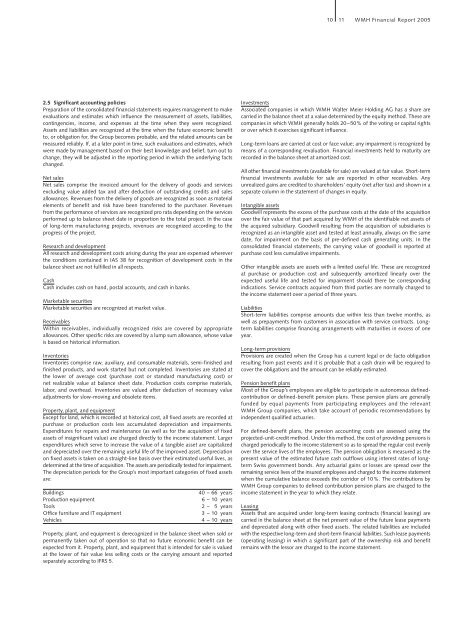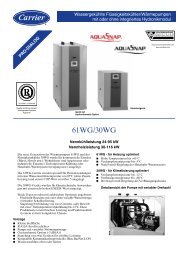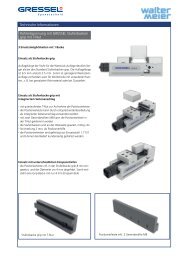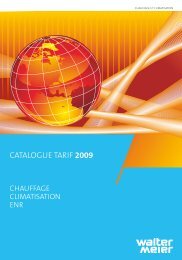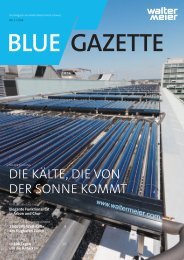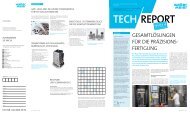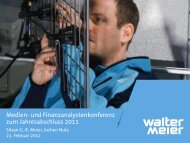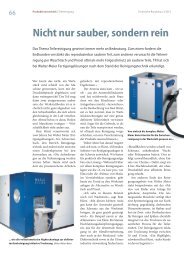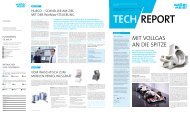Annual Report 2005 - Walter Meier
Annual Report 2005 - Walter Meier
Annual Report 2005 - Walter Meier
Create successful ePaper yourself
Turn your PDF publications into a flip-book with our unique Google optimized e-Paper software.
2.5 Significant accounting policies<br />
Preparation of the consolidated financial statements requires management to make<br />
evaluations and estimates which influence the measurement of assets, liabilities,<br />
contingencies, income, and expenses at the time when they were recognized.<br />
Assets and liabilities are recognized at the time when the future economic benefit<br />
to, or obligation for, the Group becomes probable, and the related amounts can be<br />
measured reliably. If, at a later point in time, such evaluations and estimates, which<br />
were made by management based on their best knowledge and belief, turn out to<br />
change, they will be adjusted in the reporting period in which the underlying facts<br />
changed.<br />
Net sales<br />
Net sales comprise the invoiced amount for the delivery of goods and services<br />
excluding value added tax and after deduction of outstanding credits and sales<br />
allowances. Revenues from the delivery of goods are recognized as soon as material<br />
elements of benefit and risk have been transferred to the purchaser. Revenues<br />
from the performance of services are recognized pro rata depending on the services<br />
performed up to balance sheet date in proportion to the total project. In the case<br />
of long-term manufacturing projects, revenues are recognized according to the<br />
progress of the project.<br />
Research and development<br />
All research and development costs arising during the year are expensed wherever<br />
the conditions contained in IAS 38 for recognition of development costs in the<br />
balance sheet are not fulfilled in all respects.<br />
Cash<br />
Cash includes cash on hand, postal accounts, and cash in banks.<br />
Marketable securities<br />
Marketable securities are recognized at market value.<br />
Receivables<br />
Within receivables, individually recognized risks are covered by appropriate<br />
allowances. Other specific risks are covered by a lump sum allowance, whose value<br />
is based on historical information.<br />
Inventories<br />
Inventories comprise raw, auxiliary, and consumable materials, semi-finished and<br />
finished products, and work started but not completed. Inventories are stated at<br />
the lower of average cost (purchase cost or standard manufacturing cost) or<br />
net realizable value at balance sheet date. Production costs comprise materials,<br />
labor, and overhead. Inventories are valued after deduction of necessary value<br />
adjustments for slow-moving and obsolete items.<br />
Property, plant, and equipment<br />
Except for land, which is recorded at historical cost, all fixed assets are recorded at<br />
purchase or production costs less accumulated depreciation and impairments.<br />
Expenditures for repairs and maintenance (as well as for the acquisition of fixed<br />
assets of insignificant value) are charged directly to the income statement. Larger<br />
expenditures which serve to increase the value of a tangible asset are capitalized<br />
and depreciated over the remaining useful life of the improved asset. Depreciation<br />
on fixed assets is taken on a straight-line basis over their estimated useful lives, as<br />
determined at the time of acquisition. The assets are periodically tested for impairment.<br />
The depreciation periods for the Group’s most important categories of fixed assets<br />
are:<br />
Buildings 40 – 66 years<br />
Production equipment 6 – 10 years<br />
Tools 2 – 5 years<br />
Office furniture and IT equipment 3 – 10 years<br />
Vehicles 4 – 10 years<br />
Property, plant, and equipment is derecognized in the balance sheet when sold or<br />
permanently taken out of operation so that no future economic benefit can be<br />
expected from it. Property, plant, and equipment that is intended for sale is valued<br />
at the lower of fair value less selling costs or the carrying amount and reported<br />
separately according to IFRS 5.<br />
10<br />
11<br />
WMH Financial <strong>Report</strong> <strong>2005</strong><br />
Investments<br />
Associated companies in which WMH <strong>Walter</strong> <strong>Meier</strong> Holding AG has a share are<br />
carried in the balance sheet at a value determined by the equity method. These are<br />
companies in which WMH generally holds 20–50% of the voting or capital rights<br />
or over which it exercises significant influence.<br />
Long-term loans are carried at cost or face value; any impairment is recognized by<br />
means of a corresponding revaluation. Financial investments held to maturity are<br />
recorded in the balance sheet at amortized cost.<br />
All other financial investments (available for sale) are valued at fair value. Short-term<br />
financial investments available for sale are reported in other receivables. Any<br />
unrealized gains are credited to shareholders’ equity (net after tax) and shown in a<br />
separate column in the statement of changes in equity.<br />
Intangible assets<br />
Goodwill represents the excess of the purchase costs at the date of the acquisition<br />
over the fair value of that part acquired by WMH of the identifiable net assets of<br />
the acquired subsidiary. Goodwill resulting from the acquisition of subsidiaries is<br />
recognized as an intangible asset and tested at least annually, always on the same<br />
date, for impairment on the basis of pre-defined cash generating units. In the<br />
consolidated financial statements, the carrying value of goodwill is reported at<br />
purchase cost less cumulative impairments.<br />
Other intangible assets are assets with a limited useful life. These are recognized<br />
at purchase or production cost and subsequently amortized linearly over the<br />
expected useful life and tested for impairment should there be corresponding<br />
indications. Service contracts acquired from third parties are normally charged to<br />
the income statement over a period of three years.<br />
Liabilities<br />
Short-term liabilities comprise amounts due within less than twelve months, as<br />
well as prepayments from customers in association with service contracts. Longterm<br />
liabilities comprise financing arrangements with maturities in excess of one<br />
year.<br />
Long-term provisions<br />
Provisions are created when the Group has a current legal or de facto obligation<br />
resulting from past events and it is probable that a cash drain will be required to<br />
cover the obligations and the amount can be reliably estimated.<br />
Pension benefit plans<br />
Most of the Group’s employees are eligible to participate in autonomous definedcontribution<br />
or defined-benefit pension plans. These pension plans are generally<br />
funded by equal payments from participating employees and the relevant<br />
WMH Group companies, which take account of periodic recommendations by<br />
independent qualified actuaries.<br />
For defined-benefit plans, the pension accounting costs are assessed using the<br />
projected-unit-credit method. Under this method, the cost of providing pensions is<br />
charged periodically to the income statement so as to spread the regular cost evenly<br />
over the service lives of the employees. The pension obligation is measured as the<br />
present value of the estimated future cash outflows using interest rates of longterm<br />
Swiss government bonds. Any actuarial gains or losses are spread over the<br />
remaining service lives of the insured employees and charged to the income statement<br />
when the cumulative balance exceeds the corridor of 10%. The contributions by<br />
WMH Group companies to defined contribution pension plans are charged to the<br />
income statement in the year to which they relate.<br />
Leasing<br />
Assets that are acquired under long-term leasing contracts (financial leasing) are<br />
carried in the balance sheet at the net present value of the future lease payments<br />
and depreciated along with other fixed assets. The related liabilities are included<br />
with the respective long-term and short-term financial liabilities. Such lease payments<br />
(operating leasing) in which a significant part of the ownership risk and benefit<br />
remains with the lessor are charged to the income statement.


